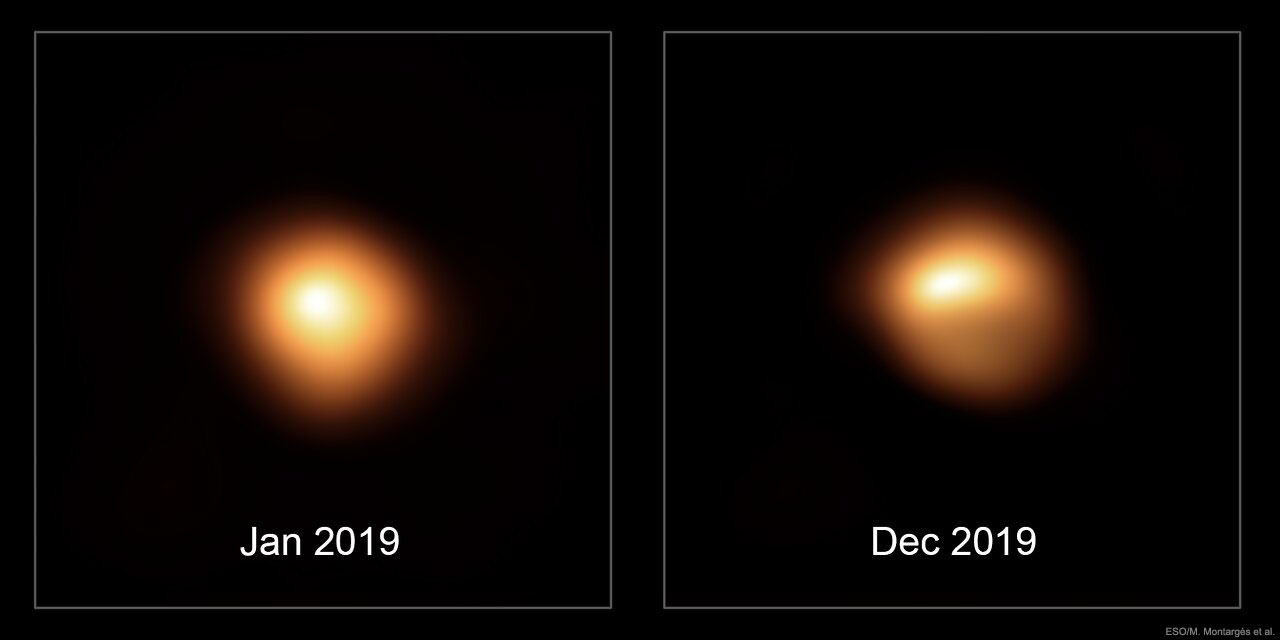Today’s APOD image is fascinating on several levels. The pair of images above are of the star Betelgeuse, a “red supergiant” (type M1-2); one at the beginning of 2019 and the other at the end of the year. Aside from our own Sun, we generally think of stars as true “point sources” of light, having no dimension. Even though Betelgeuse is an enormous star (if it were located where our Sun is its outer surface would be out past Jupiter), and relatively close at about 700 light-years, it is quite remarkable that our modern telescopes are able to actually resolve some surface detail on the star. It’s angular diameter is estimated to be about 0.05 arcseconds. To put that in perspective, when I can capture an image with a resolution of 2 arcseconds I feel very lucky. These images are at least 200 times my best resolution.
But the real story here is that Betelgeuse has been acting out over the last year, first getting a bit brighter than normal, then much dimmer. From these photos it seems that it has also become quite unsymmetrical. This might not be so unusual for Betelgeuse. It is a variable star, after all, and the most widely varying in brightness of all stars of similar brightness. What makes this particularly intriguing is that red supergiants follow the motto “live fast and die young”, so there is speculation that these changes may be foreshadowing its end. It is “only” about 10 million years old, but is very near the end of its life. Of course, in astronomical terms “very near” means within the next 100,000 years. I’m hoping that when my final diagnosis comes the doctor says “sometime in the next 100,000 years”.
When it does reach its end, Betelgeuse will explode in a supernova, ejecting huge amounts of matter in a very high energy state. Most of the more exotic elements we know of are created in supernovas. Normal nuclear reactions in a star convert hydrogen into helium, and then to other simple elements up to iron. It takes the energy of a supernova to create the more complex elements (and some take even more energetic events). You may have heard it said (I know I have) that when Betelgeuse goes supernova it will destroy life on Earth, but this is not true. We are far enough away that the radiation released will be minor. On the other hand, it will be quite a show! It will suddenly become very bright – by far the brightest star in the sky, and probably visible in the day time. It will then fade, and eventually disappear (some matter will probably remain, but will not be easily visible). Supernovas in more distant places tend to fade out in a matter of weeks, but I’m not sure how long Betelgeuse might take to fade out.
In case you are not familiar with it, Betelgeuse is the 2nd brightest star in the Orion constellation (after Rigel), and is seen as his left shoulder. Well, the shoulder we see on the left side, which would be “his” right shoulder if he were an actual being. The name Betelgeuse, like most of the major stars, comes from Arabic, but there is some dispute about its meaning and pronunciation. The pronunciation you are most likely to hear is the one that is both easy to say and somewhat comical, “Beetle Juice”. Early translation of the original Arabic took the name to mean “the armpit of Orion”, but most scholars now agree that it is actually “the hand of Orion”, and the preferred pronunciation is “BET el jooz”.
So I’m definitely not going to hold my breath waiting for Betelgeuse to explode – that would be very inconsistent with my plans for a long life. But perhaps it will get more people looking up at the night sky, which is always a good thing.
